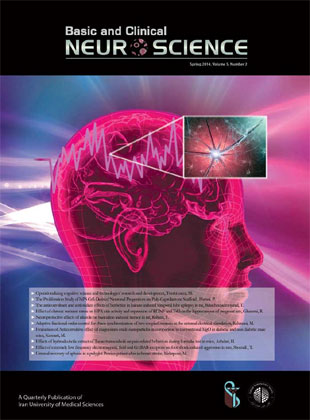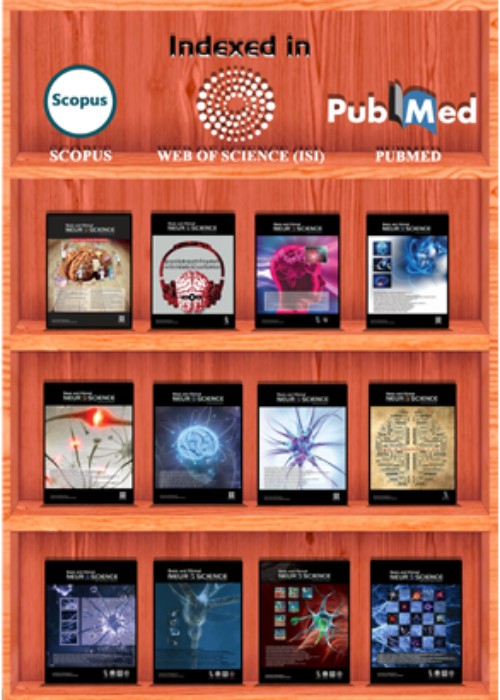فهرست مطالب

Basic and Clinical Neuroscience
Volume:5 Issue: 2, Spring 2014
- تاریخ انتشار: 1393/03/17
- تعداد عناوین: 10
-
-
Pages 104-116advances in brain and cognitive science studies have revolutionized concepts in neural dynamics, regulating mechanisms, coding systems and information processing networks which govern our function and behavior. Hidden aspects of neurological and psychiatric diseases are being understood and hopes for their treatment are emerging. Although the two comprehensive mega-projects on brain mapping are in place in the United States and Europe; the proportion of science contributed by the developing countries should not be downsized. With the granted supports from the Cognitive Sciences and Technologies Council (CSTC), Iran can take its role in research on brain and cognition further. The idea of research and development in Cognitive Sciences and Technologies (CST) is being disseminated across the country by CSTC. Towards this goal, the first Shiraz interdisciplinary meeting on CST was held on 9 January 2014 in Namazi hospital, Shiraz. CST research priorities, infrastructure development, education and promotion were among the main topics discussed during this interactive meeting. The steering committee of the first CST meeting in Shiraz decided to frame future research works within the “Brain and Cognition Study Group-Shiraz” (BCSG-Shiraz). The study group comprises scientific leaders from various allied disciplines including neuroscience, neurosurgery, neurology, psychiatry, psychology, radiology, physiology, bioengineering, biophysics, applied physics and telecommunication. As the headquarter for CST in the southern Iran, BCSG-Shiraz is determined to advocate “brain and cognition” awareness, education and research in close collaboration with CSTC. Together with CSTC, Shiraz Neuroscience Research center (SNRC) will take the initiative to cross boundaries in interdisciplinary works and multi-centric research projects within the study group.Keywords: Cognitive Science, Technologies, Brain Research, Cognition, Neuroscience, Developing Countries, Study Group, Shiraz
-
Pages 117-123IntroductionThe native inability of nervous system to regenerate, encourage researchers to consider neural tissue engineering as a potential treatment for spinal cord injuries. Considering the suitable characteristics of induced pluripotent stem cells (iPSCs) for tissue regeneration applications, in this study we investigated the adhesion, viability and proliferation of neural progenitors (derived from human iPSCs) on aligned poly-caprolactone (PCL) nanofibers.MethodsAligned poly-caprolactone nanofibrous scaffold was fabricated by electrospinning and characterized by scanning electron microscopy (SEM). Through neural induction, neural progenitor cells were derived from induced pluripotent stem cells. After cell seeding on the scaffolds, their proliferation was investigated on different days of culture.ResultsAccording to the SEM micrographs, the electrospun PCL scaffolds were aligned along with uniformed morphology. Evaluation of adhesion and viability of neural progenitor cells on plate (control) and PCL scaffold illustrated increasing trends in proliferation but this rate was higher in scaffold group. The statistical analyses confirmed significant differences between groups on 36h and 48h.DiscussionEvaluation of cell proliferation along with morphological assessments, staining and SEM finding suggested biocompatibility of the PCL scaffolds and suitability of the combination of the mentioned scaffold and human iPS cells for neural regeneration.Keywords: Poly, caprolactone Scaffold, hiPS Cells, Neuronal Progenitors, Proliferation Assay
-
Pages 124-130IntroductionTemporal lobe epilepsy(TLE) is a long lasting neurological disorder in which patients suffer from spontaneous seizures. New treatments with novel mechanisms of action are needed to help those patients whose seizures are resistant to available drugs. In this study, we investigated the possible neuroprotective effect of berberine in an intrahippocampal kainate model of TLE in rat.MethodsIn the present study, the anticonvulsant and antioxidant effects of intraperitoneal administration of berberine(25, 50 and 100 mg/kg), was evaluated in intrahippocampal kainate(4g)-induced TLE in rats.ResultsThe results showed that the kainate rats exhibit acute and spontaneous seizures in 24 hours and two weeks after intrahippocampal kainic acid injection. Administration of berberine, significantly decreased Racine score and rate of incidence of seizure in kainate rats(P<0.05). On the other hand, berberine ameliorated the lipid peroxidation(P<0.001) and nitrite(P<0.001) level, but had no effect on SOD activity.DiscussionThese data suggest that berberine pretreatment could attenuate spontaneous recurrent seizures. Since, administration of berberine decreased lipid peroxidation in kainate rats, it seems that berberine,s favourable effect is due to its effectiveness in lessening of oxidative stress in rat.Keywords: Kainic Acid, Berberine, Seizure, Hippocampus, Oxidative Stress, Rat
-
Pages 131-137IntroductionBrain-Derived Neurotrophic Factor (BDNF) and its receptor, TrkB, in the hippocampus are targets for adverse effects of stress paradigms; in addition, BDNF and its receptor play key role in the pathology of brain diseases like depression. In the present study, we evaluated the possible role of hippocampal BDNF in depression during pregnancy,MethodsTo achieve the purpose, repeated restrain stress (1 or 3 hours daily for 7 days) during the last week of pregnancy was used and alteration in the gene expression of hippocampal BDNF and TrkB evaluated by semi-quantitative PCR.ResultsThe results showed that in stress group the level of ACTH and Corticosterone is increased showing that our model was efficient in inducing psychological stress; we also found that BDNF and TrkB expression are decreased in 3 hours stress group but not in 1 hour stress compared to control group.DiscussionOur results imply that decrease in BDNF and its receptor could contribute in some adverse effects of stress during pregnancy such as elevation of depressive like behavior.Keywords: stress, BDNF, depression, ACTH, Corticosterone, semi, quantitative RT, PCR
-
Pages 138-143IntroductionExcessive olivo-cerebellar burst-firing occurs during harmaline-induced tremor. We hypothesized that antiglutamatergic agents would suppress harmaline tremor. From this point of view, the aim of current study was to investigate the effects of riluzole on harmaline-induced tremor in rat.Material And MethodsFour groups of Wistar rats weighing 80–100 g were injected with harmaline (30 mg/kg i.p.) for inducing experimental tremors. The rats in group 1 served as control, whereas the animals in groups 2, 3 and 4 were also given riluzole intraperitonealy at doses of 2, 4 and 8 mg/kg 30 min before and 90 min after harmaline administration. The onset latency, intensity and duration of tremor were recorded.ResultsThe results of this study demonstrated that riluzole could significantly increase latency period, and reduce duration and intensity of tremor.DiscussionIt is concluding that pretreatment of riluzole can ameliorate harmaline-induced tremor in rats.Keywords: Harmaline, Tremor, Riluzole, Rat
-
Pages 144-155This paper addresses synchronizing two coupled chaotic FitzHugh–Nagumo (FHN) neurons with weakly gap junction under external electrical stimulation (EES). To transmit information among coupled neurons, by generalization of the integer-order FHN equations of the coupled system into the fractional-order in frequency domain using Crone approach, the behavior of each coupled neuron relies on its past behavior and the memorized system can be a better fit for the neuron response. An adaptive fractional-order controller Based on the Lyaponuv stability theory has been designed to synchronize two neurons electrically coupled with gap junction in EES. The proposed controller is also robust to the inevitable random noise such as disturbances of ionic channels. The simulation results demonstrate the effectiveness of the control scheme.Keywords: Fractional, order, Synchronization, Neuron model, Lyaponuv function
-
Pages 156-161IntroductionSome studies show magnesium has anticonvulsive effect in some animal models. Despite of the availability of well-studied anticonvulsant drugs, this evaluation was not carried on new kind of magnesium supplement, magnesium oxide nanoparticles (nMgO). According to the interaction between magnesium and convulsion, this study was designed to evaluate the effect of nMgO on strychnine-induced convulsive model in compared to its conventional in diabetic and normal mice.MethodsHealthy male albino mice were divided to 10 groups. Diabete mellitus was induced by streptozocin in 5 groups. Conventional and nanoparticle MgO (5&10mg/kg) in presence and absence diabetes injected to mice, then strychnine injected and onset of convulsions and time of death were measured after strychnine administration.ResultsConvulsive parameters did not change in normal and diabetic mice. cMgO pretreatment did not have anticonvulsant effect in strychnine-induced convulsion in normal and diabetic mice. But nMgO significantly changed convulsion onset and death time after strychnine administration in normal and diabetic status.DiscussionAccording to our results It seems that nMgO may be important in prevention or treatment of epilepsy and has more efficacy than its conventional form to showing anticonvulsive effect that probably is related to the physicochemical properties of nMgO, specially in diabetic subjects, a point that need to further investigation.Keywords: MgO nanoparticles, Strychnine, Convulsion, Mice
-
Pages 162-168IntroductionTanacetum sonbolii (Asteraceae) is an endemic species in Iran. In the present study, we examined the effects of Tanacetum sonbolii hydroalcoholic extract on the formalin test in mice.Methods126 Swiss albino mice weighing 230-280g were used as subjects. The formalin test was performed on two control groups (marked as intact and saline groups; n = 6 in each group) and an experimental group. In all groups, the formalin test was recorded for 60 min after administration of extract and drugs in mice.ResultsThe results showed that Tanacetum sonbolii (150 and 300 mg/kg) produced significant antinociception in phase 2. In addition, different doses of Tanacetum sonbolii extract (600, 900 and 1200 mg/kg) also induced antinociceptive effects in phase1 and phase 2. On the other hand, morphine could induce antinociception in a dose-dependent manner. Diclofenac (10 mg/kg) failed to affect the pain scores compared to Tanacetum sonbolii (300 mg/kg) group.DiscussionIt seems that administration of hydroalcoholic extract of Tanacetum sonbolii has the potential to relieve pain through both central and peripheral mechanisms in persistent inflammatory nociception.Keywords: Tanacetumsonbolii (Asteraceae), Morphine, Formalin Test, Mice
-
Pages 169-172IntroductionThe present study investigated the interactive effect of GABAB receptors and extremely low frequency electromagnetic field (ELF-EMF) on foot shock-induced aggression in rats.Methodsfifty adult male rats were randomly assigned into 10 groups. Groups 2, 4, 6, 8 and 10 were exposed to 50 Hz, 500 µT ELF-EMF for 30 days 8h per day while the remaining groups (1, 3, 5, 7 and 9) were sham-exposed. At the end of this period, the animals in groups 1 and 2 received normal saline while groups 3 and 4 treated with 100 mg/kg (low dose) of CGP35348 and groups 5 and 6 injected with 200 mg/kg (high dose) of CGP35348. Groups 7 and 8 treated with 1.7 mg/kg (low dose) of Baclofen and groups 9 and 10 received 3 mg/kg (high dose) Baclofen by IP injections. Twenty min after the injection, the aggressive behavior was recorded in foot shock-induced aggression model. The number of lateral threat, lifted up threat, biting, attacking, chasing and approaching were considered as paradigms of aggressive behavior.ResultsELF-EMF, Baclofen or CGP35348 alone had no significant effect on aggressive behavior. Except that rats exposed and treated with low dose of CGP35348 demonstrated significantly higher numbers of only one of the paradigms of aggressive behavior (lifted up threats), CGP35348 and Baclofen in both doses in combination with ELF-EMF exposure had no significant effect on aggression.DiscussionGABAB receptors and ELF-EMFs had no effect (both enhancement and suppression) on aggressive behavior of rats in foot shock-induced model of aggression.Keywords: Aggressive behavior, Extremely low frequency electromagnetic field, GABAB receptors, Rats
-
Pages 173-175IntroductionAphasia is a language disorder resulting from a lesion in the cerebral cortex. In this case report, we present a polyglot patient who recovered from aphasia by speaking his newly active learned language Case Report: A 69 years old male referred with acute onset right hemiparesis and global aphasia. After imaging, he treated with 75 mg r-TPA (0.9 mg/kg). After the fourth day of hospitalization, he could name some objects and some short phrases but interestingly only in French language (although his mother language was Persian).DiscussionIn our patient, recovery was first in the last learned language and his learning memory was recovered earlier than his native languages. As in our case, we can expect to have different recovery theory that means active learning language could be the first part of recovery in aphasia.Keywords: Aphasia, Ribot\'s Law, Pitres Law


